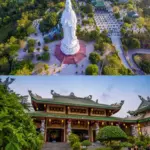Introduction to the Lady Buddha Statue at Linh Ung Pagoda in Da Nang with Ovuigo
In the heart of Central Vietnam, the Lady Buddha statue at Linh Ung Pagoda on Son Tra Peninsula stands as a monumental symbol of compassion and serenity. This towering Da Nang statue reflects centuries of Buddhist tradition, making the Linh Ung Pagoda complex a must-visit for travelers and pilgrims from around the globe. Renowned as one of the key spiritual destinations in Vietnam, this spiritual landmark is not only the highest Buddha in Vietnam but also an architectural gem that welcomes millions each year. The awe-inspiring image of Quan Am Da Nang, visible from various points across Da Nang city, draws admiration and reverence, solidifying its place in Vietnamese culture and spiritual tourism. The gardens surrounding the Lady Buddha radiate tranquility, offering a peaceful retreat amidst the dynamic pulse of Da Nang tourism. Linh Ung Pagoda’s setting, with lush gardens and panoramic views that overlook Da Nang Bay, reminds visitors of the harmony between nature and Buddhism prevalent throughout Vietnam.
https://lh3.googleusercontent.com/p/AF1QipNJ9h9FXVvK4GH-dD_M-J3YRVyeiNI6NiiFUTuH
View the Lady Buddha on Google Maps
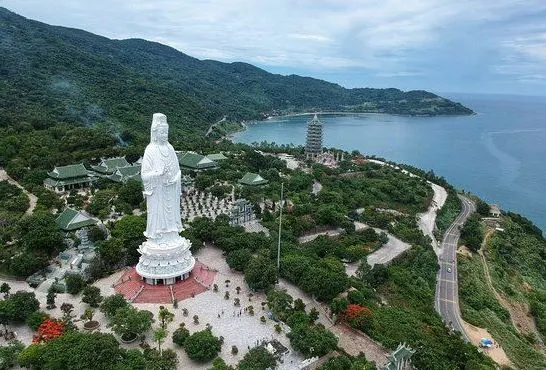
History and Significance of the Da Nang Buddha Statue
The Lady Buddha statue, locally recognized as Quan Am, was constructed within the Linh Ung Pagoda complex to mark a resurgence of Vietnamese Buddhism in Da Nang city. Consecrated in 2010, the site was chosen not only for its breathtaking view but also for its spiritual advantages, such as its role as a protector for fishermen in the East Sea. The 67-meter-high Da Nang Buddha statue is rooted in legends where Quan Am is seen as a savior for seafarers and a maternal figure in Buddhism. Since its unveiling, it has become a pilgrimage site, drawing devotees and tourists seeking blessings, guidance, and calm.
Linh Ung Pagoda itself has been a sacred destination for centuries, with past structures destroyed and then reestablished, reflecting the perseverance of Buddhist art and religious monument heritage. The iconic Lady Buddha, towering above unrest, ignorance, and materialism, serves as both a guardian and a reminder of Buddhism’s teachings of peace and compassion. Its construction used advanced engineering, ensuring typhoon resistance—evidence of how Vietnamese culture respects tradition while embracing new technologies.
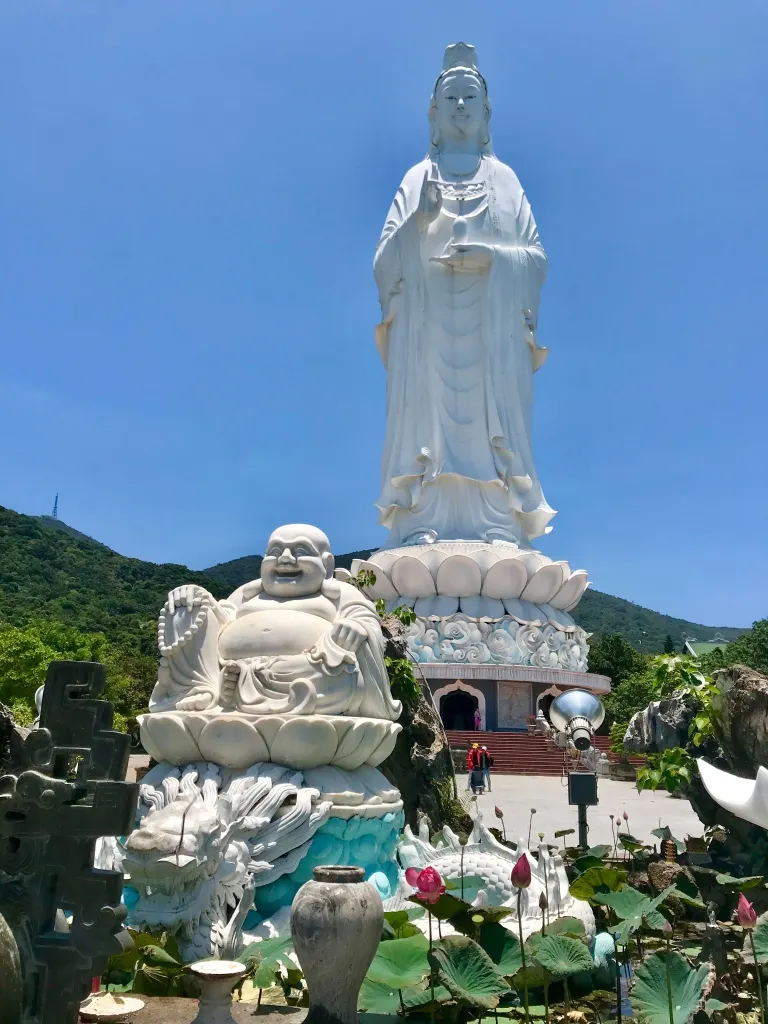
Architectural Features and Unique Characteristics of the Lady Buddha
Standing 67 meters tall, the Lady Buddha is the highest Buddha image in Vietnam. Her white figure faces the East Sea, arms gently embracing a vase—symbolizing her role as the compassionate savior of the coastal communities. The hollow interior hosts 17 accessible floors, each with an altar dedicated to different manifestations of Buddha. Visitors can ascend through chambers filled with sacred images—statues, prayer beads, lotus flower motifs, and dharma wheels—praying or quietly absorbing spiritual energy.
The statue’s lotus base, a symbol of purity in Vietnamese Buddhism, grounds the site’s spiritual presence. An innovative typhoon-resistant design allows visitors safe access, even during harsh weather. At night, the Lady Buddha is illuminated, creating an ethereal view seen from across Da Nang Bay. Her motherly pose and prayer chamber inside reinforce her role as a nurturing goddess, reminiscent of the goddess Guanyin’s symbolism across Asia. The landmark’s unique architectural form supports Buddhist pilgrimage and meditation, making it central to Da Nang tourism.
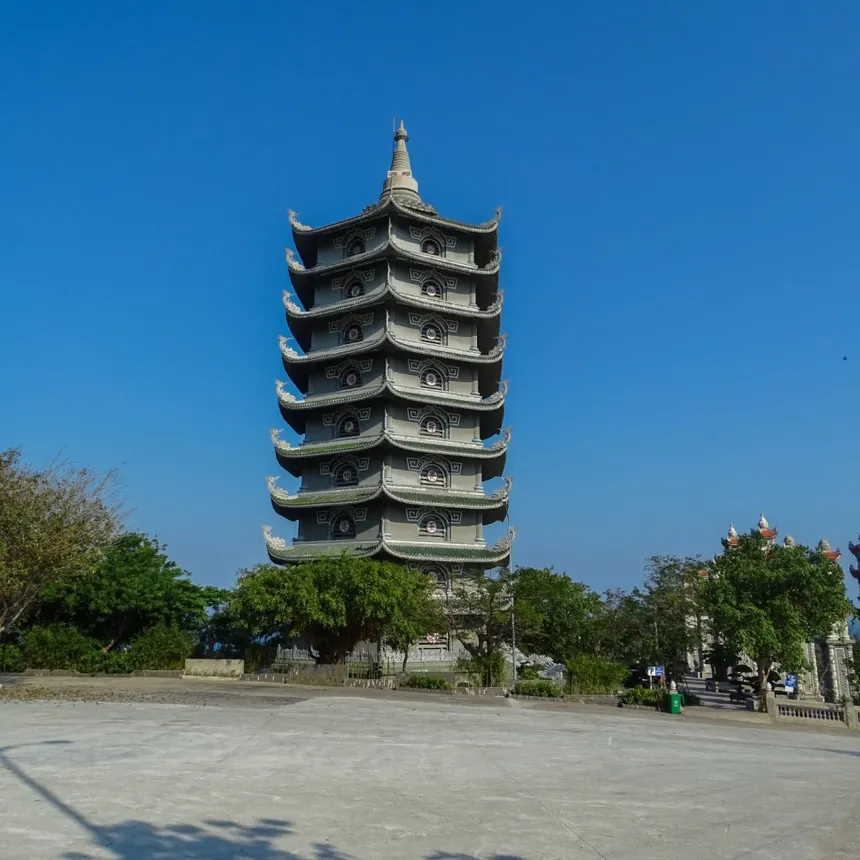
Location and Scenic Views from Son Tra Peninsula
The Lady Buddha’s placement on the lush Son Tra mountain range, within the Son Tra Peninsula, was carefully selected for symbolism and scenery. The pagoda complex overlooks Da Nang Bay, providing breathtaking panoramic views of the city skyline, gentle coastline, and the ever-changing moods of the East Sea. This vantage point, combined with tranquil gardens designed for meditation, attracts both spiritual seekers and nature lovers. Photo enthusiasts and those seeking reflection will find Linh Ung’s spacious courtyards and winding pathways ideal for peaceful walks.
Being close to Da Nang city means visitors can access the pagoda by taxi, motorbike, or guided tour, making it a convenient escape from urban bustle. On clear days, the site offers undisturbed views that capture the vibrancy of Vietnamese culture meeting natural beauty. No matter the time, the panorama—city lights at dusk or early morning sea mist—sets the Lady Buddha and Linh Ung Pagoda apart as an unrivaled sacred destination on the Central Vietnam travel circuit.
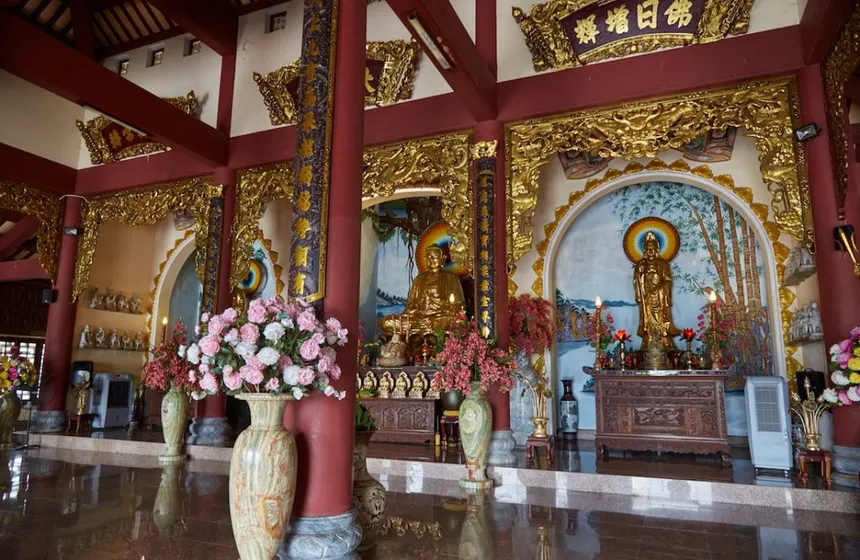
Religious and Cultural Importance in Vietnamese Buddhism
For Vietnamese Buddhism, the Lady Buddha at Linh Ung Pagoda is more than the sum of its material attributes. It stands as a protector for Da Nang’s fishermen and as an anchor for Buddhist practice. The pagoda hosts festivals during Buddhist holidays, including Vesak and Vu Lan, drawing participants from across Vietnam who gather to light incense sticks, join in processions, and meditate amidst the tranquil gardens.
The symbols present—lotus flower, dharma wheel, prayer beads, and Buddha images—are reminders of spiritual values that counter ignorance, anger, and atheism. Within the Buddha’s lotus base, prayer rooms allow for quiet supplication. Visitors and locals alike regard Linh Ung as a sacred destination, a place of spiritual rejuvenation and hope. The site serves as a bridge between tradition and contemporary Vietnamese culture, ensuring that Buddhist art and spiritual insight remain accessible to all. This religious monument is woven into the fabric of Da Nang city’s social and cultural events, delivering compassion and community to those who visit.
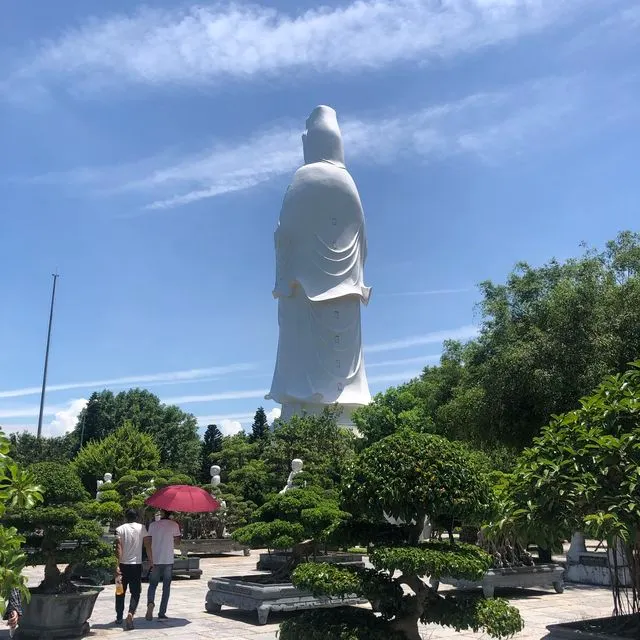
Visitor Information: Access, Best Times, and Nearby Attractions
Linh Ung Pagoda and the Lady Buddha statue welcome visitors daily from 6 AM to 9 PM. There is no entrance ticket required—admission is free, aligning with the Buddhist ideal of open access for all. To make the most of your visit, arrive in the early morning or late afternoon when the sun is softer, and the tranquility is most profound. Dress respectfully when entering the pagoda or statue, covering shoulders and knees as a sign of reverence.
The site’s pathways and interior chambers are accessible for most travelers, including families and seniors, though some floors inside the Buddha require climbing stairs. Bring water, and consider joining guided meditations or festivals when they coincide with your trip. For a complete Da Nang cultural journey, pair your visit with nearby attractions: the Marble Mountains Buddha, My Khe Beach for relaxation, the ancient streets of Hoi An for culture, the sparkling Han River promenade, and the Cham Museum for glimpses into Vietnam’s diverse religious history.
- Lady Buddha Location on Google Maps
- Linh Ung Pagoda Location on Google Maps
We don’t run tours — we craft experiences. Each journey is a story written just for you, designed for those who wish to explore Vietnam slowly, deeply, and meaningfully. No fixed itineraries. No crowds. Just you — and the moments that truly matter. For customized travel advice in Da Nang, Hoi An, or Hue, contact Ovuigo at +84868319161 via WhatsApp.
For relaxing and unique accommodations, discover The Manor Hoi An, Hola 1, and Hola 2.


